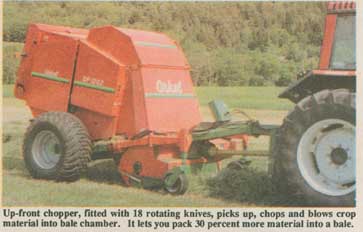
Chopping hay as you bale increases bale density and improves hay quality while cutting costs.
The Norwegian-built OrkelGP 1202 baler is being imported to the U.S. and Canada by Norse Products, Winnipeg, Man. It uses 18 rotating knives to pick up, chop and blow the crop up a chute and into the bale chamber. It produces bales that are on average 30 percent denser than conventional round bales. That means there's less air in the bales, which speeds the silage making process (if you wrap bales), and reduces baling, wrapping, and handling costs because you end up with fewer bales.
Dave Turner, market manager for Norse Products says the bale chopper also produces higher quality feed. "It chops hay in lengths from 3 to 6 in. Chopping it splits the stem and releases sugars, producing high quality silage faster," he notes, adding that it also makes baled straw easier to handle for bedding or to mix into forage rations.
The Orkel baler produces 4-ft. dia. bales 4-ft. wide that weigh between 1,300 and 2,600 lbs., depending on dry matter. Bales are formed by 13 large steel rollers mounted on heavy-duty greasable bearings and driven by individual chains. Bales are wrapped by netting in order to contain the shorter material. The baler is fitted with high load capacity flotation tires. The machine requires an 80 to 90 hp tractor.
"Chopped hay is much easier to feed out than conventional silage bale material, resulting in higher feed intakes and improved animal performance," says Turner, noting that in addition to making silage bales, the machine can also be used to cut forage on a daily basis for livestock.
The chop baler works equally well on hay and straw, says Turner. The ribbed pattern on the bale forming rollers grabs onto dry straw as easily as wet hay.
